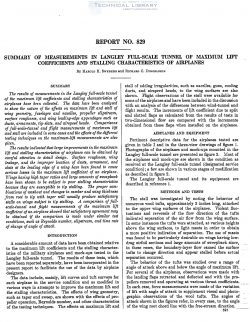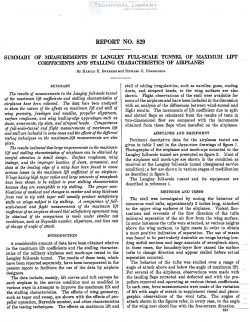naca-report-829

- Version
- 168 Downloads
- 2.77 MB File Size
- 1 File Count
- August 31, 2016 Create Date
- August 31, 2016 Last Updated
National Advisory Committee for Aeronautics, Report - Summary of Measurements in Langley Full Scale Tunnel of Maximum Lift Coefficients and Stalling Characteristics of Airplanes

The results of measurements in the Langley full-scale tunnel
of the maximum lift coeficients and stalling characteristics of
airplanes hare been collected. The data have been analyzed
to show the nature of the efects on maximum lift and stall of
wing geometry, fuselages and nacelles, propeller slipstream,
surface roughness, and wing leading-edge appendages such as
ducts, armaments, tip slats, and airspeed heads. Comparisons
of full-scale-tunnel and flight measurements of maximum lift
and stall are included in some cases and the ejects of the difi'erent
testing techniques on the maximum-lift measurements are also
given.
The results indicated that large improrements in the maximum
lift and stalling characteristics of airplanes can- be obtained by
careful attention to detail design. Surface roughness, wing
leakage, and the improper location of ducts, armament, and
slats at the leading edge of a wing hare been found to cause
serious losses in the maximum lift coej‘icient of an airplane.
Wings having high taper ratios and large amounts of sweepback
have been shown to be subject to poor stalling characteristics
because they are susceptible to tip stalling. The proper com-
binations of washout and changes in camber and wing thickness
from root to tip with taper will usually produce satisfactory
stalls on wings subject to tip stalling. A comparison of full-
scale-tunnel and flight measurements of the maximum lift
coefficient of an airplane showed that satisfactory agreement may
be obtained if the comparison is made under similar test
conditions, such as Reynolds number, slipstream, and time rate
of change of angle of attack.
A considerable amount of data have been obtained relative
to the maximum lift coefficients and the stalling character-
istics of the military airplanes and mock—ups tested in the
Langley full-scale tunnel. The results of these tests, which
have been reported separately, have been incorporated in the
present. report to facilitate the use of the data by airplane
designers.
| File | Action |
|---|---|
| naca-report-829 Summary of Measurements in Langley Full Scale Tunnel of Maximum Lift Coefficients and Stalling Characteristics of Airplanes.pdf | Download |
Comment On This Post